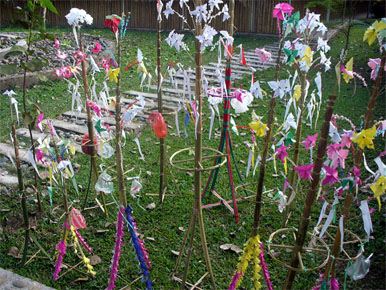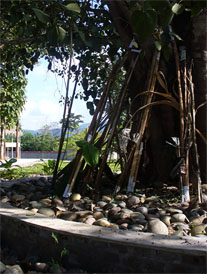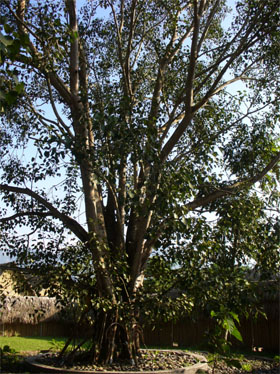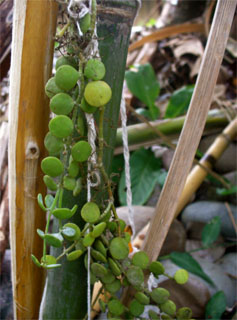Acknowledging Spiritual Realities-
Ecological Knowledge, Cultural Connections, and Spiritual Agency in
Dai Theravada Buddhism*
David Matthew Hecht
Luther College
Keywords: knowledge, plants, spirituality, human agency, Buddhism
Introduction
Each day at Manting temple begins with meditation while the sun rises and ends with meditation as the sun sets. Days are filled with quiet practice and modest work—sweeping fallen leaves with palm frond brooms, washing bamboo sitting mats in the temple courtyard, or hanging up curtains in the nunnery. Life within the temple walls feels simpler, slower—more intentional somehow. For resident Buddhist monks and nuns this is the nature of monastery life. However, on select days throughout the year, the pace of community life is adjusted to accommodate a time of festival and celebration—a time when farmers and shopkeepers take a break from their daily obligations to celebrate with food, music, dancing, and worship. The local temple halts routine daily practice to prepare and host the incoming community of Buddhist practitioners worshiping, praying, and celebrating community and connections to the ancestors and the Buddha. On the day of the biggest Dai Buddhist festival of the year, life is celebrated in full and connections to the ancestors and the Buddha are renewed.
On the 21st of October, dozens of monks in flowing orange robes and hundreds of farmers and villagers come to the temple to light incense and candles and to say prayers for hours around the large white pagoda near the edge of the temple complex. During the day, some practitioners bring balls of white string—attaching an end to the large golden Buddha statue inside the main temple and the other end to a single type of tree found throughout the temple grounds. Others will leave prayers attached to wooden branches as well as collections of flowers, food, or structures of bamboo and leaves at the base of this great tree in worship. This tree the Dai call guomaixili, otherwise known as the Puti Tree. It is a sacred tree in Theravada Buddhism and a key component in many Dai Buddhist rituals. Although the medicinal qualities found in the blossoms and oil of the tree may be one reason for its reverence, the main reason for its high status is the Puti tree’s historical and symbolic connection to Sakyamuni Buddha. Under this tree, the Buddha attained enlightenment and release from samsara—the cycle of death and rebirth in the world. Because of this ancient connection, the tree is understood to be the single most profound representation of the Buddha in Dai Theravada Buddhism. And for those who live or pray at the temple, the Puti tree acts as a direct link to the Buddha in prayer and is often the medium for cultivating Buddha nature needed to reach nibbana.1
The Dai people of Xishuangbanna, China are well recognized in the province for their complex and multifaceted cultural relationships with the local ecology. Here, we can see just one example of the relationship between human spirituality and the world of local plant ecology in the Dai social universe. In this paper, I aim to illustrate how ecological knowledge plays a crucial role in spiritual practices and rituals of the Dai people. In particular, I will show how pharmacological characteristics and historical connections in the plant world shape the spiritual agency of practicing Dai Buddhist monks and laymen. Finally, on a grander scale, I hope to present an example of how an anthropological approach that recognizes the subjective realities of their informants and focuses on human spiritual agency can help to manage and conceptualize the complexity of human-environment relationships in a spiritual context.
How is Agency Defined in the Dai Context?
To better understand what I mean by spiritual agency, we must first examine the way agency is typically approached in the realm of anthropology and social theory. For Anthony Giddens, “ ‘Action’ or agency . . . does not refer to a series of discrete acts combined together, but to a continuous flow of conduct” (1979:55). In other words, agency can be viewed as a reflexive moment of attention that results in a flow of day-to-day activity and action performed by a human agent. He argued that the concept of agency has two components: a) the notion of action as it relates to activities of an agent that not only include movements but also involve intervention in “a potentially malleable object-world” (Giddens 1979:56) and b) the notion that the agent, at any point in time, could have acted otherwise—a reflection of decision and choice as an element of agency.
This is the typical way in which agency is understood in social theory. My use of agency is similar, with a few key differences. Rom Harre suggested that “social knowledge and skill are involved in the genesis of action and accounts . . . an individual’s ability to do each depends upon his stock of social knowledge” (1979:57). At its core, this paper mirrors Harre’s approach to understanding the structure and origin of action capacity by illustrating how socio-cultural knowledge is involved in the nature of action. I illustrate this understanding of action and agency in the context of spiritual practice and add interrelating temporal and spatial components to the notion of agency. More specifically, I attempt to illustrate how ecological knowledge of both temporal and medicinal plant characteristics help to condition Dai spiritual action and agency. In essence, then, this paper refers to agency as the capacity of individuals through time, space, and even following death to act within or alter their own conceptual reality (whether in the physical or the spiritual realm).
The concept of spiritual agency can be understood as the capacity for spiritual action or animation. This agency arises from the ability of human agents to perform a task for some greater spiritual purpose. When discussing agency in the Dai context, we need not only look to current Buddhist practitioners that adopt the role of acting spiritual agents but we can also understand agency as being the product of human agents through time—whether important spiritual figures like the Buddha or the passed ancestors of a certain family. In this paper, plants are the medium to which spiritual agency is applied. And it is the ethnobotanical knowledge systems of the Dai people and associated plant characteristics that shape the spiritual agency of Buddhist practitioners.
Spiritual Agency and Historical Associations
Plant focused spiritual agency can be understood through various mechanisms in the Dai cultural world. Plants that can act as connectors with individuals through time and history can be especially powerful in shaping the initiative for spiritual action—through processes of meditation, prayer, worship, or ritual practices. Keep in mind that it is not necessarily the passage of time that is the compelling aspect of practical agency, it is instead the human-botanical connections that exist within that history that provide a plant with so called historical qualities. This is one of the many plant qualities that seems to have a particularly strong power in the realm of spiritual application for Dai practitioners.
Dai Bamboo Burial StructuresIf we go back to the first illustrated narrative, describing the connection between the historic Buddha and the Puti tree, we see an example of how human spiritual agency is applied to the realm of plants through the mechanism of historic connections and associations. Cultural knowledge of the Puti tree’s special significance to Buddhism is what gives the spiritual rituals associated with the tree a certain amount of animation and power. One could say that the Puti tree’s historical connection to the Buddha triggers the feeling and the presence of the deceased Buddha’s agency in the modern world—his ability to act, to perform. “The relics and images of the Buddha thus are the physical form in which ideas about the continued presence of the Buddha’s agency lives on” (Pyysiäinen 2009: 182). It is this type of connection and cultural understanding that drives the potential for spiritual action.
Recall the ritual of attaching white string between the golden Buddha statue and the Puti trees outside the main temple. What exactly do we see here in the context of practical spiritual agency and the plant world? For the Dai people, this physical act of connection has a multifaceted purpose. In a general sense, this string indicates and in many ways performs a status of possession: a) this action not only illustrates the representative and historical link between Sakyamuni and the Puti tree but b) it also indicates possession of the planter of the tree to that specific Puti tree. Because the Puti tree belongs to the Buddha (the Dai people say they are the same), the string that connects the golden Buddha to an individual Puti tree indicates the possession of that tree to its planter. Every year, then, this individual will return on the 21st of October to set another line to his/her tree. Not only does this performance, this act, sustain the connection between an individual practitioner and his/her resident Puti tree but, in many ways, it maintains and results from a cultural understanding of the tree’s historical connection to Buddha, its significance to Buddhism, and its role in spiritual action and agency at the temple.
Other plants that encompass connections to a larger sense of time and space (in this case to the personal history of Dai Buddhist practitioners) are also at work within the temple complex in the form of ancestor reverence rituals. During the festival, multiple tall ritual structures made from bamboo and wrapped Talipot palm leaves were found around the central white pagoda2 and various Puti trees. These offerings were constructed to include colorful paper representations of flowers and paper bird feathers called mao. For the Dai, when a family member dies, the family will typically create a standing bamboo structure to guide their loved ones toward the Buddha after death. Each structure is made strong and vertical and is said to represent a flying bird. Because the color white represents purity and Buddha nature, most of the paper articles were white. This bamboo bird structure, when complete and placed around the Pagoda2 or the Puti tree, flies the deceased to the Buddha after death. Because of this, many families typically hang bags of food for the dead on their journey—small bags of red chilies, sugar, and other daily rations were most commonly found.3 The burial structure example we see here presents another illustration of the connections between time, history, plants, and spiritual agency. By deconstructing its components we can better understand its purpose and importance in discussions of spiritual agency in Dai ritual practice.
Plant OfferingsThis particular ritual incorporates specific plants and consequently has specific intentions, one of which is ancestor reverence—a practice that is commonplace in Dai society. First we can see how the use of popular foods comes into play. By incorporating the daily or preferred foods of a deceased family member in their burial structure, a link is drawn between the history of that individual’s relationship with edible plants and the continued future relationship that will exist following death. This personal knowledge helps to condition the subtleties of the ritual. Secondly, the bamboo representation of the bird seems to be a constructed substitute for the transportative bird of the spiritual realm. By representing the actual journey the dead take through a physical mapping and construction of the transporting unit in real space/time, the living can actively direct the dead to the Buddha—expressing their spiritual agency. Finally, by incorporating the Puti tree in the performance of the ritual, a tree that acts as a spiritual “connector,” in a sense, through time and space to the Buddha, we can see another intentional use of the Puti tree’s connecting qualities for a larger spiritual purpose.
The Puti TreeAll the components must be present in order for this afterlife ritual to work. This cultural understanding of the characteristics and uses of local plants, in ritual practice and daily life, underpins the capacity for plant based spiritual action in the form of Buddhist ritual; it conditions the existence of the ritual in the first place. Even though the structure is created for a deceased human, the purpose of the structure is to be spiritually viable and so the structure itself can be understood as a representation of the living agency of the deceased ancestors. As illustrated by this vignette, the Dai burial structure process and purpose is yet another example of the way interactions with plants in the Dai social universe can help shape the spiritual actions and identities of it’s Buddhist practitioners.
Spiritual Agency and Medicinal Plant Characteristics
The Puti tree is the center of many religious rituals in Dai culture and spiritual practices. Lets look at another example related to the Buddha tree that not only maintains connections with the historic Buddha but also to pharmacological knowledge systems and their application for Dai people.
The Button OrchidAt the base of the Puti tree behind the temple, Dai people throughout the year place tree branches with sharpened, paper wrapped tips, large banana leaves, and crude wooden bows and string with the same small epiphytic plant attached to each one.4 This plant is the Button Orchid. For Dai people, these offerings have a specific purpose, derived from pre-Buddhist belief systems and associated rituals that are dependent on the structure and materials used in constructing the offerings. For the former, bits of paper are put over tips of branches to hide the sharpened edges—effectively warding off malevolent spirits that cause illness, disease, and unhappiness in Dai households. In a similar vein, the Dischidia plant is attached to representative wooden hunting bows in an attempt to drive away the evil spirits that are causing an illness in the family. The Button orchid is not only used in this specific ritual context to take away unhappiness and drive away spirits, but it is also a popular wild growing medicine for the Dai people.5 Evidently, its connection to driving away illnesses by channeling Buddha’s agency is based on the knowledge of its real world medicinal qualities the plant possesses within Dai society.
Shaping Spiritual Agency
With the knowledge that a diverse array of plants are used in Dai Buddhist ritual practice, how can we better understand the role of plants with specific pharmacological characteristics in the shaping of Buddhist spiritual agency?
Both of the aforementioned ritual actions help to illuminate cultural perceptions of nature and the conceptual origin of things like illness, death, and disease. In using sharpened bamboo staffs and plants attached to hunting bows to scare away malevolent spirits, we can presume the perception exists that malevolent spirits can cause sickness and disease.
Sugar and Cone PepperWhen considering the use of any medicinal plant in illness-driven rituals, we can understand the situation as a spiritual response by human agents to the illness of a family member or friend through ritual practice. It is the cultural knowledge of the pharmacological properties of certain plants that shape the agency and spiritual action performed by practitioners. In homes stricken with illness and resulting unhappiness, the button orchid when medicinally prepared is understood to possess not only real world curative properties but a spiritual component as well. The resulting spiritual impact, relieving the pain or symptoms of the sick, is the product of the spiritual agency expressed by a Buddhist practitioner and the living agency of the Buddha through the Puti tree. Only via the performed ritual is the spiritually derived medicinal quality of the plant expressed. Without the intricate medicinal knowledge systems of Dai society, these particular rituals would not exist in the same way.
These rituals, along with other ceremonies and prayers for real-world benefits, imply a perceived degree of connection between the human world and the spiritual landscape as well as a level of acting spiritual agency; the fact that plants play a crucial role in the process of these rituals illuminates their inherent importance as mediums in the spiritual lives of acting agents in Dai society. This particular example also helps to illustrate the vast ecological knowledge that still exists today and plays a role in larger cultural movements, practices, and spiritual circumstances.
Spirituality beyond Metaphysics
Often in the realm of anthropology, notions of spirituality and religion in ethnographic studies are forced within a logical framework constructed of western positivistic terms and ideas. Sometimes, ethnographic data collected on religious practice and spiritual worldviews, in particular, are frequently used as “if it were metaphor or symbol, not reality, commenting that such and such ‘metaphor’ is congruent with the function, structure, or psychological mindset of the society” (Turner 2003:148). This approach, according to Edith Turner, effectively denies the common humanity, “as that humanity extends itself into the spirit world,” that exists between the anthropologist and the people they study. Doing this, we can lose sight of the components of certain practices that help to illuminate qualities of human nature and expression that are often universal in how one approaches the reality of the spiritual realm. In essence, viewing spiritual practice as a psychological structure of society—as symbol or metaphor—is lacking in the way in which it comments on the nature of spiritual practice. If social theory or anthropology remains informed by a relative ethnographic context denoting the realities of cultural practices, then it contributes a crucial perspective to the way we understand components of ritualized human action. This method of ethnography may illustrate or help to illuminate larger concepts of humanity, reality, and the way the social sciences approach religious practice.
For Geertz, spirituality and ritual are constructs that operate to “make sense out of lived experience, by giving it form and order” (1979:140). This kind of construction seems to be just as real and pressing a concern as some of the more familiar biological necessities of humanity; it is a fundamental construct. For the Dai people, many Buddhist rituals give form and order to the worldviews held by practitioners. In one of the relayed stories, we see how deceased ancestors possess a living human agency when met with bamboo constructions of the birds that take them to the Buddha after death; In another example, we see the understanding that the Puti tree and the Buddha are connected through time and history in the white string ritual of dualistic possession. For humans, spiritual practices and actions show how “events are not just there and happen, but they have a meaning and happen because of that meaning” (Gertz 1979: 131). In fact this kind of ritual approach to reality seems to be a universal—a shared human drive or desire to form some factual baseline from one’s own thoughts and actions with performed spirituality. In the Dai context, the people’s knowledge of and daily use of certain plants falls within this pattern of ethnographic understanding as well. With the ritual of attaching medicinal plants to wooden hunting bows, we can recall how evil spirits that cause sickness and disease are warded away from the families that perform such rituals. If all family members remain healthy throughout the year, this reality is not the result of chance or haphazard good fortune but is in fact the product of consistent prayer and ritual performance to the Buddha during the course of the seasons.
These are rituals that are performed because of the understood meaning or the understood reality of the relationship between medicine, sickness, healing, and spirits. When these rituals produce their intended results, the collective understanding of reality and the workings of the world as it applies to spirituality are understood in factual terms. This is the lived reality of a particular group of people in the context of religion—it is arguably a reflection of the nature of religion as it pertains to all of humanity. As Geertz argued, “religion supports proper conduct by picturing a world in which such conduct is only common sense . . . in sacred rituals and myths, values are portrayed not as subjective human preferences but as the imposed conditions for life implicit in a world with a particular structure” (1973: 131). All the rituals and spiritual practices of Dai people, those performed within the confines of the Dai Buddhist festival on the 21st or outside of it, are patterns that seem to summarize, for a people, what it knows about living—what it knows about reality. And as anthropologists, if we approach the spiritual practices of others with the recognition that such actions are expressions of a fundamental reality for those people, then we can acknowledge our common humanity with our subjects.
It is important then that we take this expression of spirituality seriously in the realm of ethnography. One way to approach this challenge is to focus less on the perceived symbols or apparent metaphors of spiritual practice and more on the means and nature of spiritual action or spiritual agency. Concentrating on the concept of agency can get us beyond simple reflections and metaphysical questions by illuminating cultural realities as they relate to action, activity, movement, and intervention in a malleable world (Giddens 1979:56). Geertz explained that, “religion is never merely metaphysics. For all peoples the forms, vehicles, and objects of worship are suffused with an aura of deep moral seriousness” (Geertz 1973:126). By approaching spirituality from a standpoint of agency, one automatically goes beyond the metaphysical understanding of religion; practical agency inherently includes components of the physical realm, the acting realm, the structural realm, the agential realm, etc. Such an approach can help highlight, as Geertz said, people’s common sense understandings of their lived realities. And still we lose nothing in the current discourse of social structure and agency in the spiritual context by focusing on the realities of human spiritual action. In fact, it is Anthony Giddens who moved beyond the duality of structure and agency that exists in the realm of social theory and argues that social structure is both the medium and the outcome of social action.
By approaching ethnographies of religion or spiritual practice with an agency-focused mindset, we may find it easier to integrate ourselves into all components of our subject’s spiritual reality, avoiding the tendency to relate spiritual practice simply to symbol and metaphor that comes with our positivistic cultural insights. And if we approach ethnographic research with this acknowledgement of a subjective spiritual reality, a deep moral seriousness in the reality of religion, then the anthropologist “can understand and collect certain material that could have been gathered in no other way” (Turner 2003: 146). As a result, one is approaching an understanding of a culture less as an objective outsider and more as an individual who is inhabiting the subject’s world and its cultural conception of it—a practice Edith Turner referred to as “going native.”
Why spiritual agency?
So how does a focus on spiritual agency contribute to what we know and understand about the relationships between spiritual beliefs, botanical knowledge, and resulting human action? With a thematic focus centered on concepts of agency, one can provide simultaneous insight and draw connections between cultural and environmental factors that play a role in the nature and practice of spirituality. For spiritual agency to be discussed, one must first identify the agent, the result of agency, and the application of that agency. In this particular case study, a focus on spiritual agency allows for the inclusion of human religious practitioners, past or present, in the big picture discussion of spirituality (the agents). Additionally, one can draw connections between the motivations of spiritual action, whether to cure a sick family member or indicate personal possession, and the action itself, in the form of rituals, meditation, or other religious practice (results of agency). When delving deeper into the intricacies of spiritual agency, one also has the capability of including the application and influence of spiritual agency in explaining larger themes of cultural action. In this particular study, we see agency application in the utilization of the plant world in Buddhist rituals. Because the ability to think, act, and react in a practical manner is arguably a fundamental quality of human beings, focusing on the intricacies that shape this fundamental agency in the context of spirituality illuminates certain components of human nature that help to explain why we do what we do in the realm of religious practice.
Conclusion
The intent behind religious plant use is complex and multifaceted; some plants are used for the secondary qualities they possess as a member of a particular species. Other plants are used in prayer offerings because of their spiritually-driven medicinal healing abilities for ill family members. Others have direct connections to Buddhist tradition and are therefore an integral component in Buddhist thought and perceptions towards the plant world. In this particular case study, it seems as though connections to personal and/or religious history and qualities of healing in plants have the capacity to condition spiritual practices through agentive practitioners. It is these concepts and relationships that can be used to guide the veneration of relics and beings in the spiritual discipline (Pyysiäinen 2009: 165). Acknowledging these cultural approaches to reality with a degree of moral seriousness allows anthropologists to view more fully fundamental aspects of human nature and spirituality otherwise masked in approaches run on positivistic ideologies. By viewing the relationship between cultural knowledge and active spiritual engagement through the holistic identity of spiritual agency, such a case study can help illuminate the complexities that exist between human culture, spirituality, and the natural world without relying on narrow, isolating methods of ethnography.
Literature Cited
Geertz, Clifford. (1973). The Interpretation of Cultures. New York, NY: Basic Books. 125-141.
Giddens, Anthony. (1979). Central Problems in Social Theory: Action, Structure and Contradiction in Social Analysis. Los Angeles, CA: University of California Press. 49-95.
Harre, Rom with Peter Marsh and Elisabeth Rosser. (1978). The Rules of Disorder. London: Routledge. 15.
Pyysiäinen, Ilkka. (2009). Supernatural Agents: Why We Believe in Souls, Gods and Buddhas. New York City, NY. Oxford University Press, Inc.
Turner, Edith. (2003). "The Reality of Spirits." Shamanism: A Reader. Edited. Graham Harvey. New York, NY: Routledge, Print
*This paper is the product of a larger research project I conducted in Ganlanba, China during a study abroad experience with SIT: Chinese Culture and Ethnic Minorities in the Fall ‘10. My interests in botany, traditional ecological knowledge, and spiritual ecology have come together in this project with the intention of providing an example of the complex relationships that can exist between humans and their local ecology.
With the Tropic of Cancer separating temperate climate zones to the north and tropical climate zones to the south, Yunnan province, China is an area of tremendous ecological and cultural diversity. The tropical Xishuangbanna Prefecture in southern Yunnan is one of the most culturally and biologically complex places in the province and the whole of China. In studying local expressions of the relationships that exist between tropical plant ecology, ecological knowledge of Xishuangbanna’s Dai people, and Theravada Buddhist religious practices in Ganlanba, China, I aim to present an example of the complexities that exist between humans, human spirituality, and the natural world while acknowledging the spiritual realities within the Dai socio-cultural universe. As a representative case study of the way local ecology can help condition our human ecology (and vice versa) in manners of culture, practice, perception, and behavior I hope to provide insight into the impact of ecological knowledge on Dai spiritual agency.
1 Translated as the Dai equivalent of Nirvana- my main informant in the field was the temple grounds expert and was referred to as “uncle”- a name used because of his familial relation to the residing abbot, Du Bi Hand. Uncle’s ideas were gathered through on-site translations. His thoughts and perspective helped comment on the larger cultural concepts relating to Dai Buddhist spirituality in my study.
2 Pagoda- this structure is also a representation of the Buddha, the color white is a representation of purity and Buddha nature (Uncle)
3 These reflections and connections are those of two Dai individuals in the field while working through a series of translations. While these views may not be representative of every Dai practitioner, their thoughts and comments draw on Dai perspectives and therefore help to comment on larger cultural concepts relating to Dai Polytheism and spirituality.
4 Dischidia (vahl) Merr. also known as biebu or doŋ pi (IPA) in the Dai language
5 Information provided by Uncle
|




